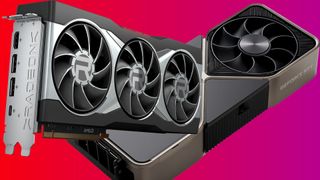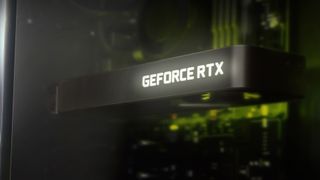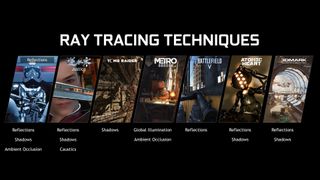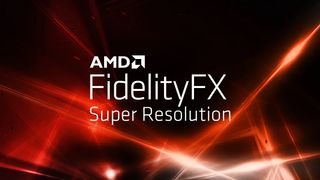Graphics card comparison: here's how Nvidia stacks up to AMD in 2022
This is how today's graphics cards compare against each other

If you're considering a new gaming PC build then graphics card comparisons are likely to be near the top of your to-do list. Whether you've got your eye on the latest models from either Nvidia or AMD, there's a fair amount you need to know before putting money down - especially in today's tech landscape.
At a time when the best graphics cards for gaming are harder than ever to get your hands on, the question becomes less about the price differences of each model, and more about the technological and architectural advantages that each manufacturer brings to the table. A graphics card comparison between Nvidia and AMD comes down to more than what's baked onto the chip.
We have considered everything from the overall availability of both brands' offerings from the cheap graphics cards and the higher-end flagships alike. What's more, we've taken a deep dive into supersampling and ray tracing technology, too, to give you an encompassing view of what these GPUs can do in 2022.
AMD Radeon RX 6000 series vs Nvidia RTX 30 series
Nvidia GeForce RTX 30 series
- Ampere architecture
- GDDR6 / GDDR6X memory
- Prices start from $249 (RTX 3050)
- Up to 24GB VRAM (RTX 3090)
- Up to 10,496 GPU cores (RTX 3090)
- Up to 384-bit memory bus
- GPU rollout began in 2020
AMD Radeon RX 6000 series
- RDNA 2 architecture
- GDDR6 memory
- Prices start from $199 (RX 6500 XT)
- Up to 16GB VRAM (RX 6900 XT)
- Up to 5,120 GPU cores (RX 6900 XT)
- Up to 256-bit memory bus
- GPU rollout began in 2020
Nvidia vs AMD graphic card comparison
AMD vs Nvidia graphics card comparison: value for money
While there are entry-level models available from both AMD and Nvidia in 2022, historically, the former has held the upper hand with more affordable hardware. The same can be said with Radeon RX 6000 Series, with the cheapest graphics card model carrying an MSRP of just $199. The RX 6500 XT, with 4GB GDDR6 memory and a 64-bit memory bus may not sound like much on paper, but this 1080p-focused GPU has enough grunt for today's games in Full HD.

Should you be wanting bang for your buck from the 30 series, however, then the RTX 3050 is the way to go. This model carries a starting MSRP of $249 for GPUs featuring 8GB GDDR6 memory and a 128-bit memory bus - making it far more capable than AMD's 2022 offering. We gave the newest of the Ampere lineup a decent write-up in our RTX 3050 review, praising it for its 1080p prowess in demanding titles. The major caveat, though, is that RTX 3050 stock is far more challenging to find at actual retail prices, unlike that of RX 6500 XT stock at the moment.
If you had the choice between either the RTX 3050 or the RX 6500 XT at their respective MSRP, then our personal recommendation would be to bet on team green here. You're getting double the VRAM, which will come in handy as the 4GB memory found in the latter model is already quite narrow and many of today's games are pushing past this allowance. It isn't unheard of for modern titles to use 6GB+ for textures these days either, so you would be giving yourself some headspace.
- Winner: Nvidia
AMD vs Nvidia graphics card comparison: availability
If you've kept up with the graphics card market over the last two years then you'll no doubt be aware of just how spiked the current prices are. When it comes to Nvidia vs AMD, it's Nvidia's RTX 30 series line that has suffered the most from both the Founders Edition models and that of the partner cards, too.
Sign up to the GamesRadar+ Newsletter
Weekly digests, tales from the communities you love, and more
In order to combat supply chain shortages, team green went about releasing Ti refreshes ahead of schedule. However, the half-step video cards were quickly just as challenging to track down for MSRP except in rare circumstances.
The AMD Radeon RX 6000 Series, while still evasive, has enjoyed slightly better availability in territories such as the US and UK since launch. While the prices aren't quite MSRP, it is generally easier to find the likes of the RX 6600 for under the $500 mark than it is for RTX 3060 and RTX 3060 Ti stock, for instance.
If you're after a graphics card to throw in your machine at a decent rate then you may benefit from an AMD card close to MSRP over a price-spiked RTX 30 series GPU at this point in time.
- Winner: AMD
AMD vs Nvidia graphics card comparison: High-end GPUs
If you're after as much graphical processing power as possible then your high-end GPU options are a little more clean cut. Nvidia is leading on this front with its RTX 3090 graphics card, complete with 24GB GDDR6X VRAM and a 384-bit memory bus for $1,499. It's a seriously powerful video card that's been built specifically for 4K.
AMD isn't too far behind with its Radeon RX 6900 XT, though. While this particular video card doesn't quite have the same grunt on a frame-by-frame basis, these GPUs are closer than they may first appear. This model carries an MSRP of $999 and features 16GB GDDR6 VRAM and a 256-bit memory bus. While not quite as powerful as the Nvidia's leading card, the RX 6900 XT weighs in at $500 cheaper at release than RTX 3090 stock.
While both video cards are incredibly powerful and an asset to anyone wanting 4K gameplay in 2022, should you have the choice of both, our money is on the RTX 3090 on the whole. That extra VRAM and upgrade to GDDR6X over the standard GDDR6 of AMD's frontrunner. At the time of writing, RTX 3090 PC deals present the most cost-effective ways of getting your hands on high-end GPUs.
- Winner: Nvidia RTX 3090

AMD vs Nvidia graphics card comparison: ray tracing
While both the latest graphics cards by Nvidia and AMD feature support for ray tracing in the latest games, there's certainly a difference in which manufacturer comes out on top. Nvidia was the first of the two to heavily promote ray tracing functionality in its cards, being on the second of the RTX line now with Ampere (RTX 30 series), previously Turing (RTX 20 series).
Ampere graphics cards feature second-generation ray tracing cores and third-generation Tensor cores (for DLSS). For reference, Big Navi GPUs utilize first-generation of hardware-accelerated ray tracing cores. So while AMD video cards can do it, the technology isn't quite as established in these models to give Team Green a run for its money (yet).
- Winner: Nvidia
DLSS vs FSR: which super sampling tech is superior?

On the surface, both Nvidia's Deep Learning Super Sampling (DLSS) and AMD's FideltyFX Super Resolution share a lot in common. These are upscaling technologies that utilize A.I. in order to provide a frame rate boost with minimal impact to the overall picture quality compared to running games natively.
Ray tracing is incredibly taxing on hardware, that's where the beauty of DLSS comes in handy:
It's split between four quality settings; quality, balanced, performance, and ultra-performance, with the image quality decreasing slightly depending on the usage. DLSS works by rendering the game in real-time at a lower native resolution and then upscaling to the desired resolution. For instance, in Control, playing in 4K with DLSS on performance mode renders natively at 1440p, but is presented in 2160p.

FSR, however, doesn't rely on Tensor cores but instead acts as a form of post-processing which is far less hardware-intensive to implement. It's based on an algorithm that essentially uses sharpening filters and edge detection to provide a better-looking image and higher frame rates than native resolution.
The major advantage that FSR has on DLSS is that the former technology is available through far more graphics cards than the latter, as DLSS is only supported by RTX 20 and 30 series.
As for which of the supersampling technology is better, in actuality, it's entirely dependent on the game's optimization and support that makes all the difference. For example, a game that's got Nvidia's backing, such as Metro Exodus, will be greatly enhanced by DLSS on the latest Nvidia cards. However, a title like Far Cry 6, will scale the best through FSR on AMD hardware, especially factoring in those 11GB HD textures.
In many cases, the latest PC games support both DLSS and FSR regardless of optimization, so if the graphics card your machine is running has support for the A.I. upscaling tech then it's definitely worth turning on. To our eyes, they look and work about as well as each other, providing a pivotal frame rate boost while taking some of the computing stress off the GPU itself.

- Tie
Nvidia RTX 30 series graphics card comparison
Every RTX 30 series is built upon the Ampere architecture, with the minimum amount of memory being 8GB GDDR6, as found in both the RTX 3050, RTX 3060 Ti, and RTX 3070. Curiously enough, the RTX 3060 standard features 12GB VRAM instead.
Things begin to change when taking the mid-tier of RTX 30 series graphics cards into comparison. The biggest leap that the RTX 3070 Ti makes over the original model is a bump up to GDDR6X memory for faster overall bandwidth. Should you be after a cheaper line of video cards with the latest memory, RTX 3070 and RTX 3070 Ti stock have you covered.
This is the same memory type as used by the RTX 3080, RTX 3080 Ti, and the RTX 3090, so the playing somewhat levels out in this regard. The major difference that determines the power potential of each Ampere GPU is the memory bus width size that the graphics cards are built onto, with smaller sizes meaning that less data is being transferred for less performance.
This is evident with the RTX 3050, the cheapest and weakest of the RTX 30 series, as while it has the same 8GB GDDR6 memory as both the RTX 3060 Ti and RTX 3070, it is far less capable with larger amounts of data due to its 128-bit memory bus. For reference, the RTX 3060 Ti features a 256-bit memory bus, as does the RTX 3070, meaning those cards have an easier time handling higher resolutions (like 1440p and 2160p) more consistently. RTX 3060 PCs and RTX 3070 PCs are closely matched in price, but we recommend aiming a little higher should your budget allow.
With RTX 3080, RTX 3080 Ti, and RTX 3090 being marketed on their 4K prowess, this is where the total amount of VRAM and memory bus width becomes greatly expanded. The RTX 3080 utilizes a 320-bit memory bus and 10GB memory, however, the RTX 3080 Ti and RTX 3090 feature a 384-bit memory bus as well as 12GB and 24GB GDDR6X memory respectively. RTX 3080 stock is the cheapest out of the three, with the price gap slim between RTX 3080 Ti stock and RTX 3090 stock in today's market.

Radeon RX 6000 graphics card comparison
AMD's Radeon RX 6000 Series of graphics cards is the company's latest line which is built upon RDNA 2 architecture. Each Big Navi GPU can be divided up into three categories depending on the individual card's power level; 1080p, 1440p, and 4K gaming ready.
The cheapest, and most recent card in the lineup is the Radeon RX 6500 XT which is billed on its entry-level 1080p performance in modern games. It is the only GPU in the Radeon RX 6000 line-up to feature 4GB GDDR6 and a consequently smaller 64-bit memory bus. Similarly, the RX 6600 and RX 6600 XT are video cards built for high-end gaming in 1080p, with frame rates far exceeding 60 FPS at max settings. This is due to 8GB GDDR6 memory and a 128-bit memory bus.
For 1440p performance, the Radeon RX 6700 XT and RX 6800 are the video cards that you want to be considering. AMD's core strategy over Nvidia in this respect is to produce GPUs with higher clock speeds and more VRAM, and this is evident with the 12GB and 16GB memory respective to each graphics card here.
Finally, there's the true 4K / enthusiast level of AMD RX 6000 Series graphics cards, the RX 6800 XT, and the RX 6900 XT. Both GPUs use 16GB VRAM and a 256-bit memory bus. These cards are roughly equivalent to the RTX 3080 Ti and RTX 3090 respectively in terms of power level.
Should you buy Nvidia or AMD graphics cards?
Comparing Nvidia and AMD is ultimately going to come down to what you want to get out of a graphics card in 2022. AMD and Nvidia graphics cards have never been so similar in goal, though offer competitive benefits over one another when all is said and done. You can generally find the Radeon RX 6000 Series easier than the RTX 30 series at prices, closer to (but rarely matching) MSRP.
Both FSR and DLSS have come a long way since the technologies' inception, and both hardware manufacturers are clearly working hard to prioritize in-game image upscaling in tandem with ray tracing. Support for more games continues to come out on a weekly basis from both Nvidia and AMD, and, to our eyes at least, there is very little discernable difference between the two even side-by-side.
The major strength boasted by Nvidia is the ray tracing and the sheer graphical grunt of the RTX 3090, which is something that AMD just cannot live up to right now. While the red corner can flex its faster clock speeds and lower price of entry, from a raw technical point of view, it cannot compete with the industry-leading performance on display from team green.
Continue your PC-building journey in confidence with the best CPU for gaming, best PC cases, and best gaming monitors.

Aleksha McLoughlin served as the Hardware Editor for GamesRadar from June 2021 until August 2022. Her main area of expertise was the PC gaming platform, which comprised buying guides, features, reviews, and news coverage on components and prebuilt machines. She was also responsible for gaming chairs and storage. She now works on a freelance basis while studying to become a university lecturer specializing in English for foreign territories. Prior to joining GamesRadar, she wrote for the likes of Expert Reviews, The Rory Peck Trust, No Clean Singing, Vinyl Chapters, and Tech Spark while also working with the BBC.
Most Popular



